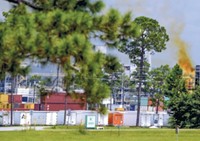Advertisement
Grab your lab coat. Let's get started
Welcome!
Welcome!
Create an account below to get 6 C&EN articles per month, receive newsletters and more - all free.
It seems this is your first time logging in online. Please enter the following information to continue.
As an ACS member you automatically get access to this site. All we need is few more details to create your reading experience.
Not you? Sign in with a different account.
Not you? Sign in with a different account.
ERROR 1
ERROR 1
ERROR 2
ERROR 2
ERROR 2
ERROR 2
ERROR 2
Password and Confirm password must match.
If you have an ACS member number, please enter it here so we can link this account to your membership. (optional)
ERROR 2
ACS values your privacy. By submitting your information, you are gaining access to C&EN and subscribing to our weekly newsletter. We use the information you provide to make your reading experience better, and we will never sell your data to third party members.
Safety
Feds End Probe Of Tesoro Blast
Inquiry: No charges filed as Justice Department closes criminal investigation of fatal accident
by Glenn Hess
August 22, 2014
| A version of this story appeared in
Volume 92, Issue 34

No one will face criminal charges in connection with the April 2010 refinery explosion and fireball that engulfed and killed seven Tesoro workers in Anacortes, Wash., the U.S. Justice Department says.
Shortly after the accident, prosecutors and criminal investigators launched an inquiry to determine whether federal environmental and worker safety statutes and regulations were violated.
“This tragedy demanded careful and thorough investigation,” says U.S. Attorney Jenny A. Durkan. “I am satisfied that the investigators and the experienced environmental attorneys in my office evaluated all the evidence and determined it does not reach the exacting bar for criminal prosecution.”
The four-year investigation included interviewing past and present employees, reviewing thousands of documents, and consulting with industry experts.
Tesoro spokeswoman Tina Barbee tells C&EN that the petroleum refiner “appreciates the government’s diligent and thorough investigation of this incident. We are pleased with this decision, which we believe is consistent with the facts.”
The tragedy at the Anacortes refinery “serves as a constant reminder of the importance of our ongoing dedication to continuous improvement in process and personal safety,” Barbee adds.
The blast was the deadliest refinery accident in the U.S. since a 2005 explosion killed 15 people and injured 180 at a BP refinery in Texas City, Texas.
The federal Chemical Safety & Hazard Investigation Board (CSB) released its final report on the Anacortes accident in May. It said safer practices and better steel could have prevented the deadly explosion at the facility, located about 70 miles north of Seattle on Puget Sound.
But CSB also blamed lax oversight by federal and state regulators for the catastrophic rupture of a nearly 40-year-old heat exchanger at the refinery, which leaked and ignited highly flammable hydrogen and naphtha. Equipment at the facility had not been inspected in decades for the type of corrosion that caused the explosion during a maintenance operation, according to the safety board’s investigation.




Join the conversation
Contact the reporter
Submit a Letter to the Editor for publication
Engage with us on Twitter